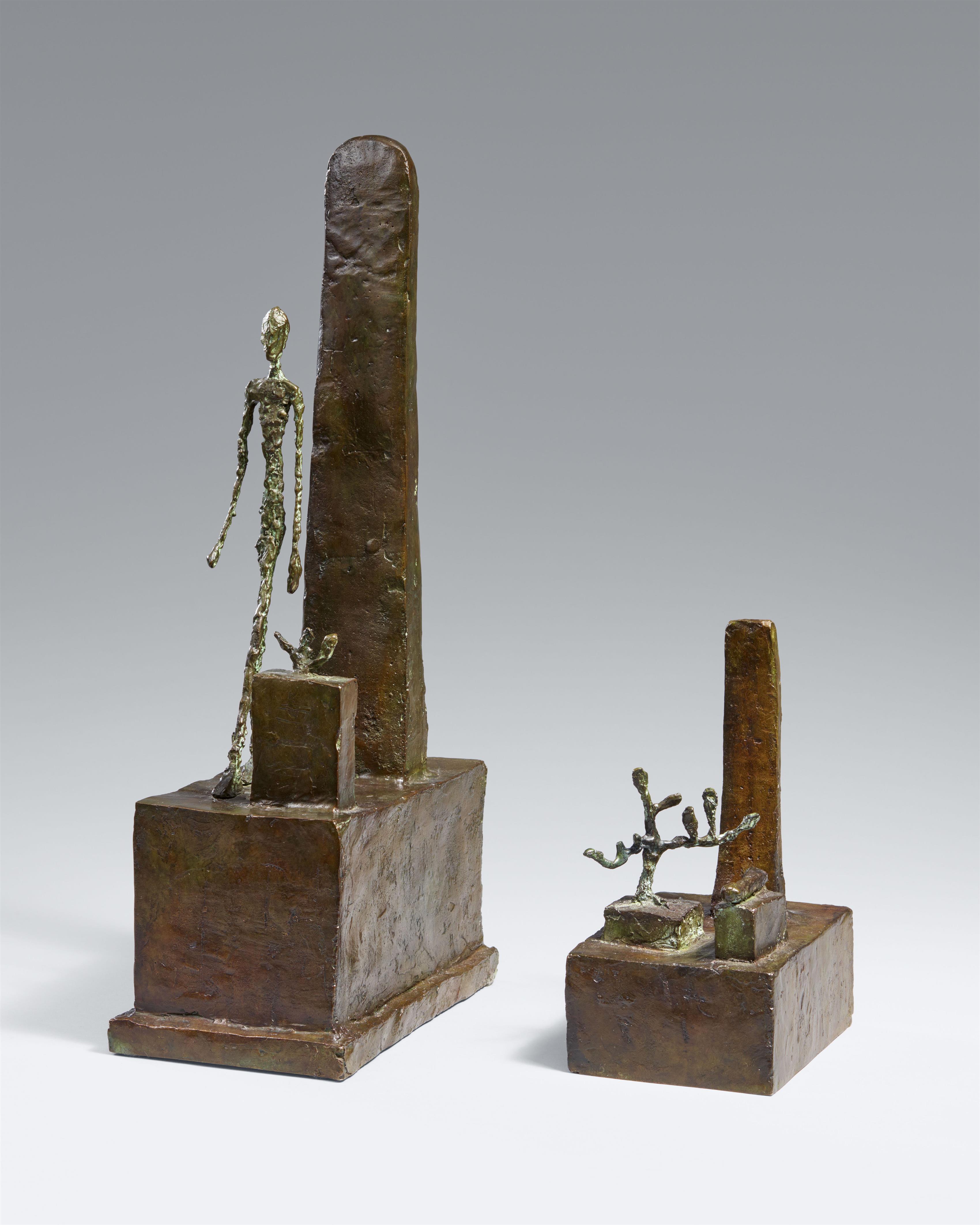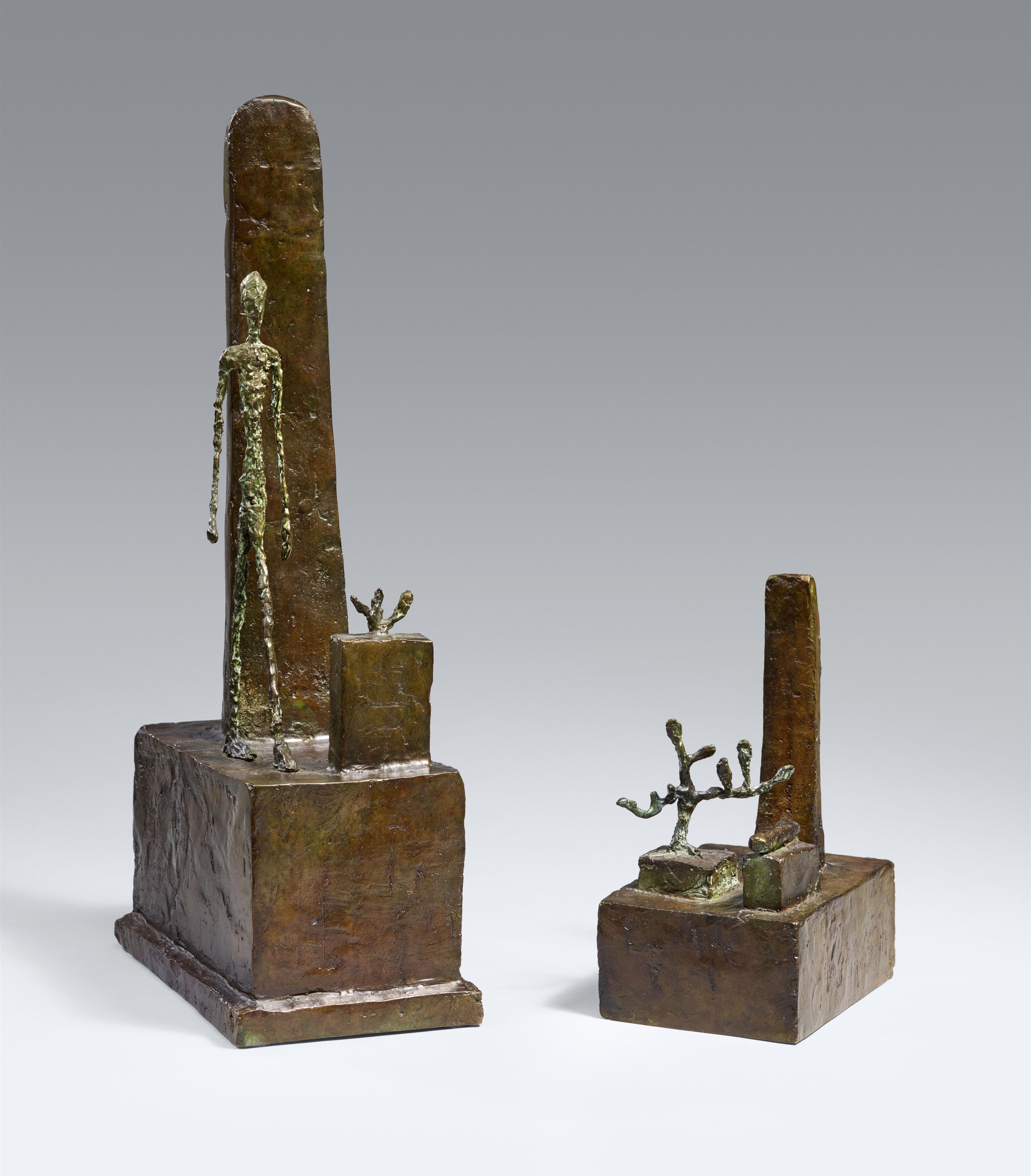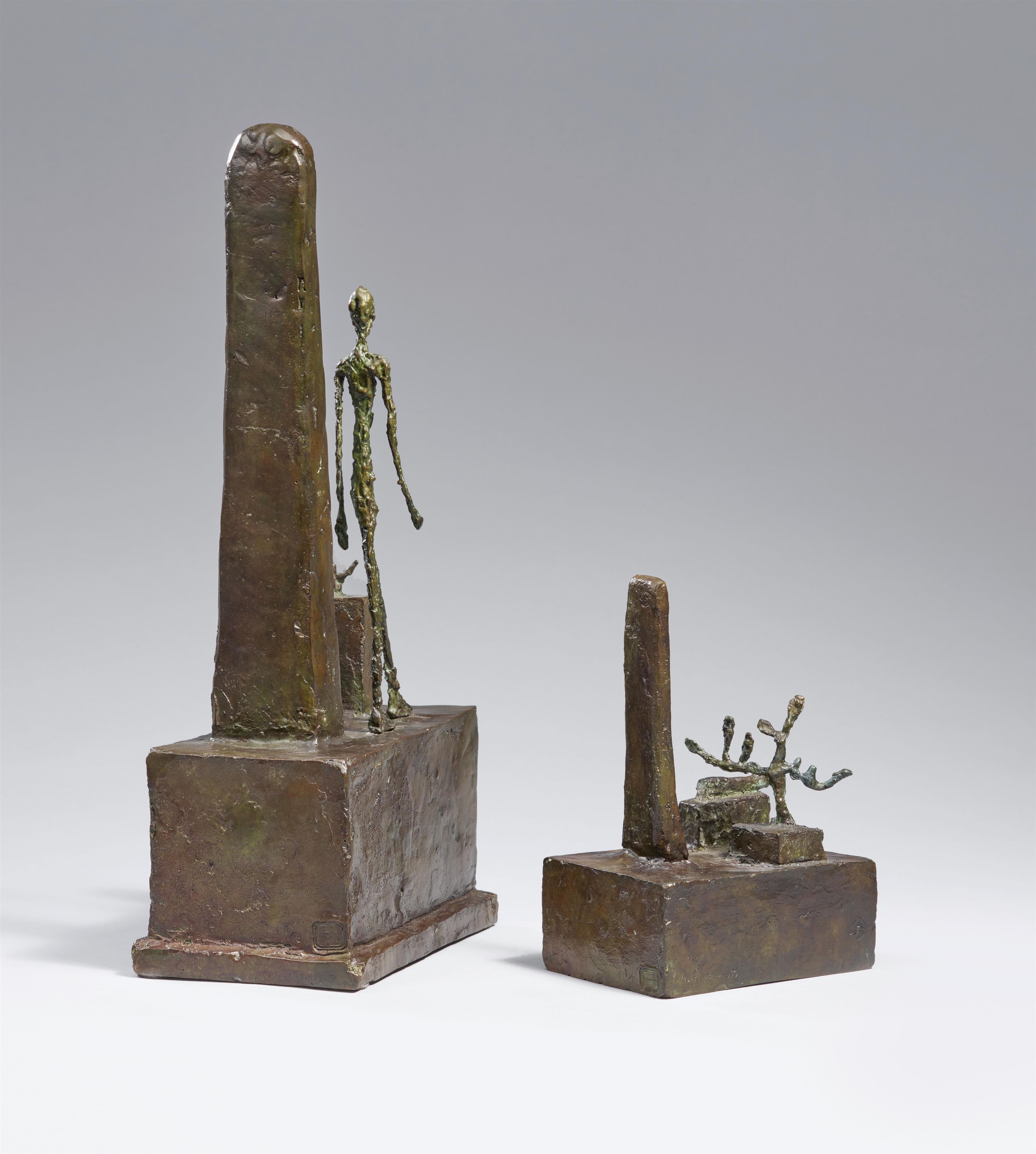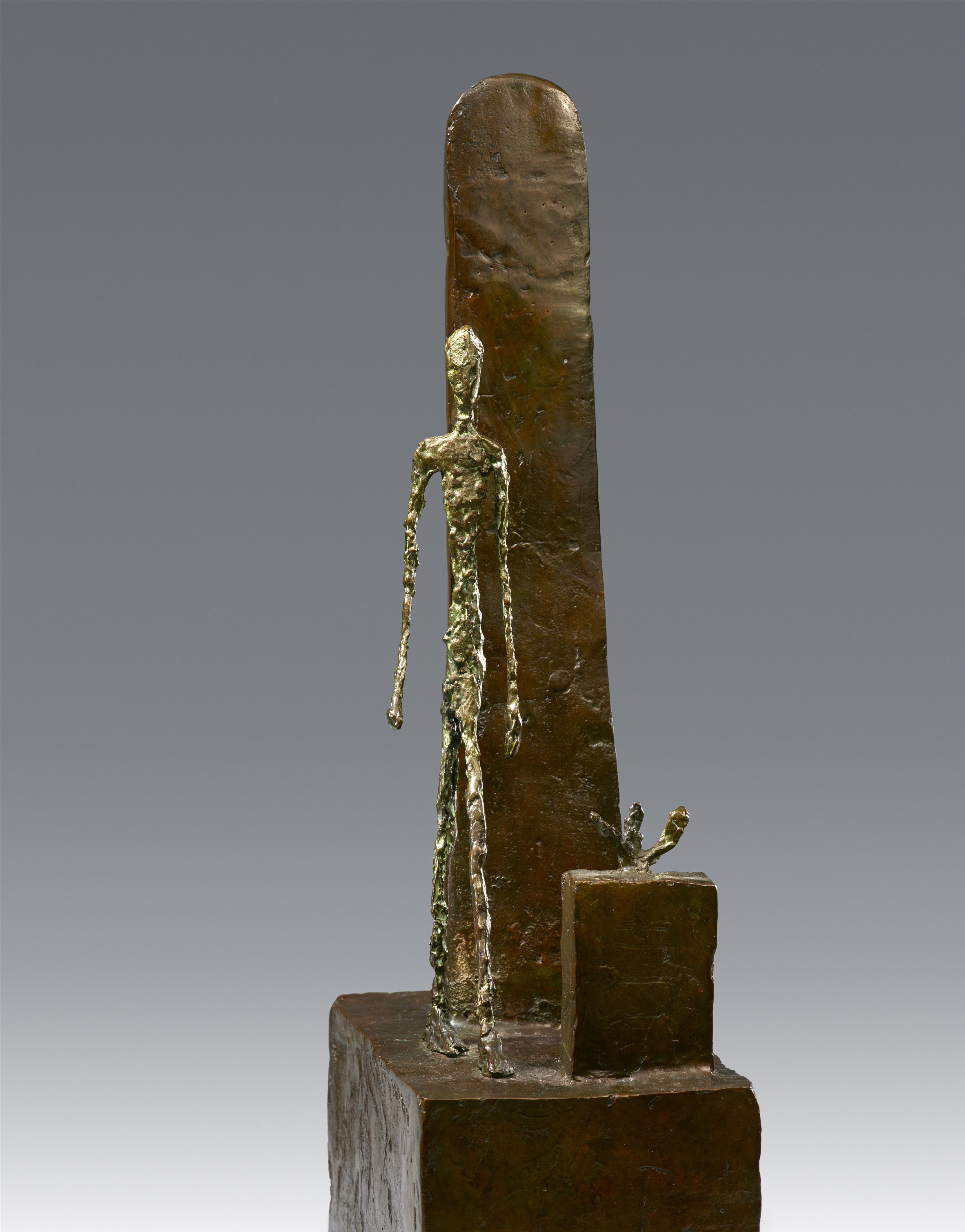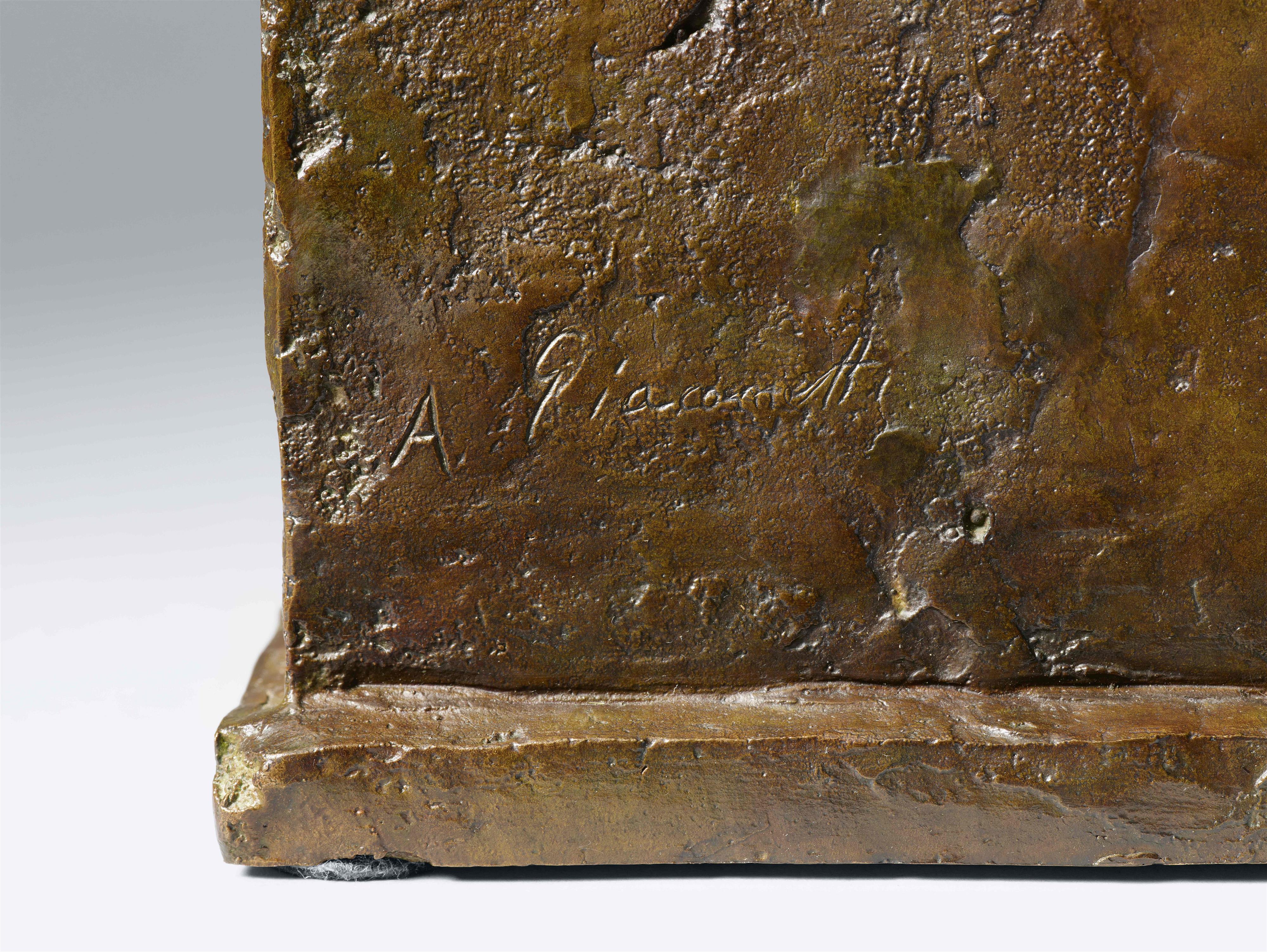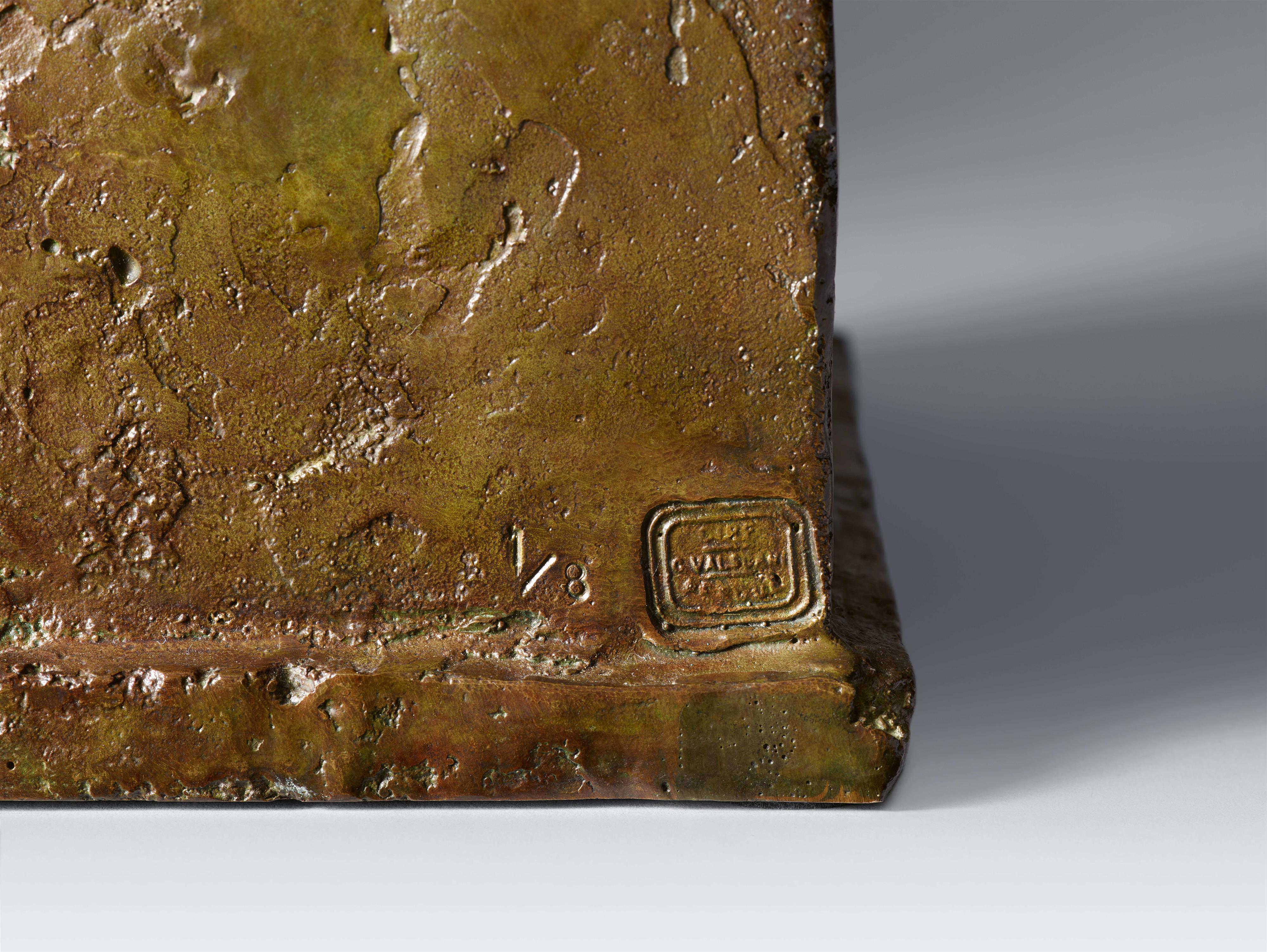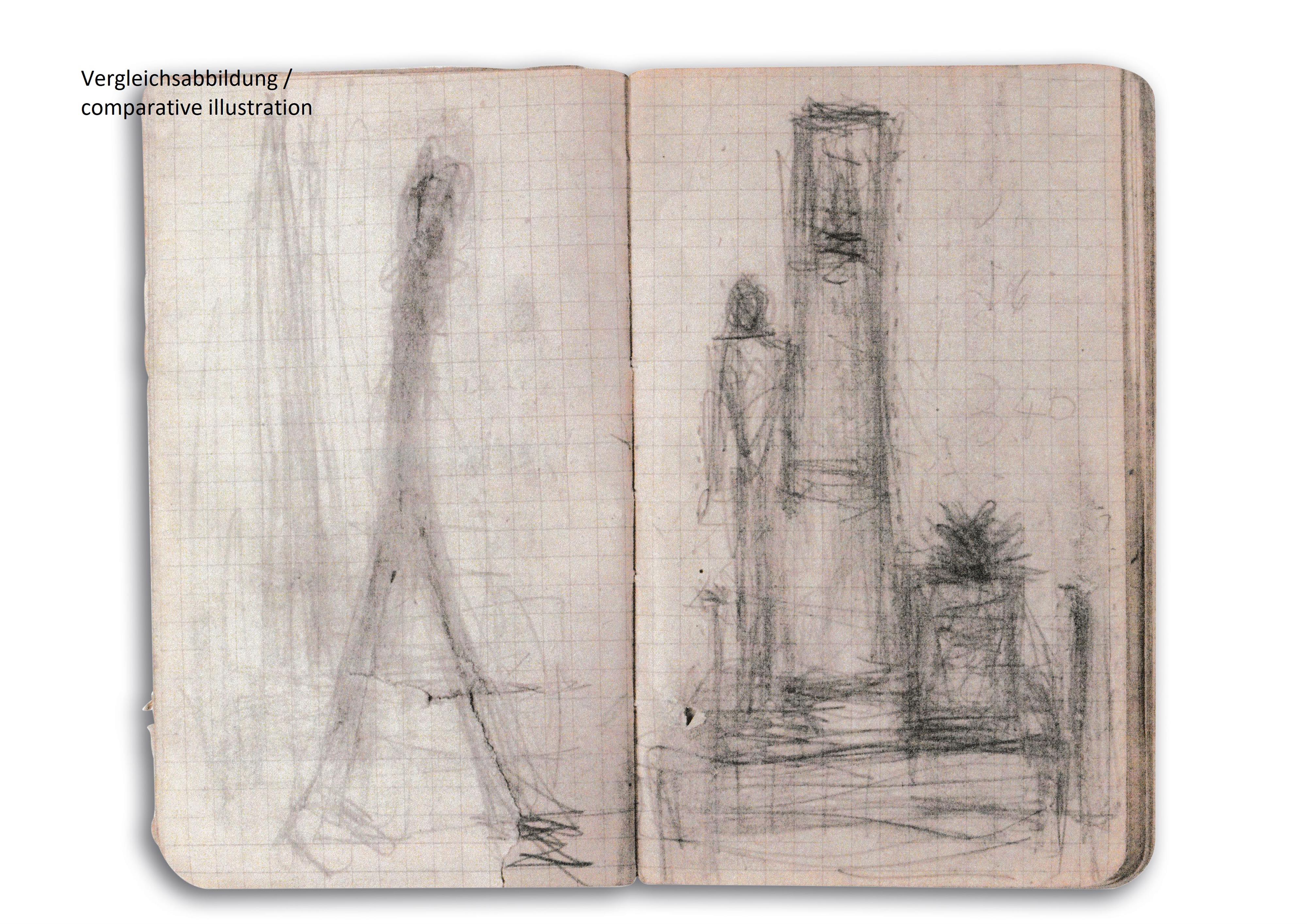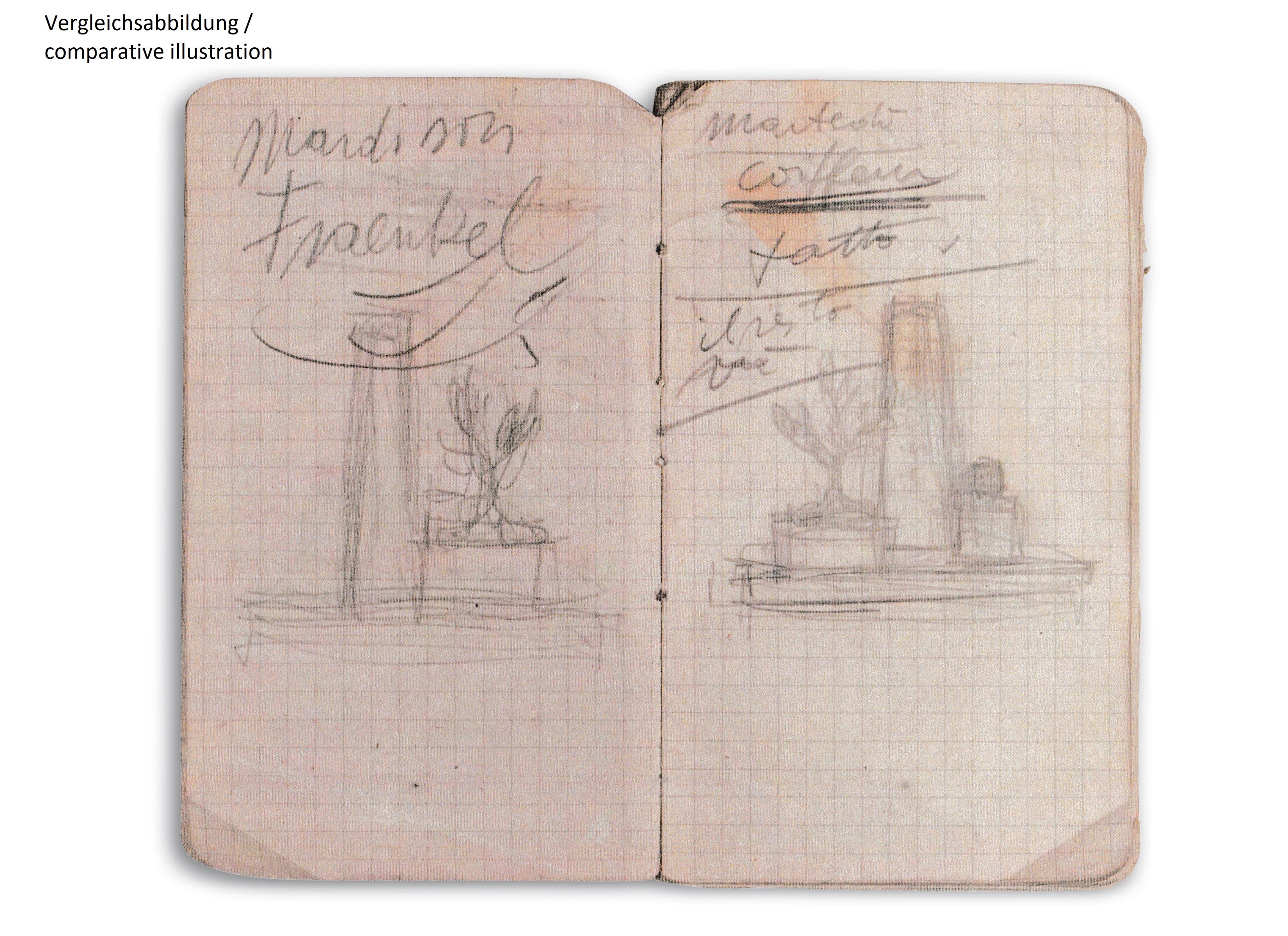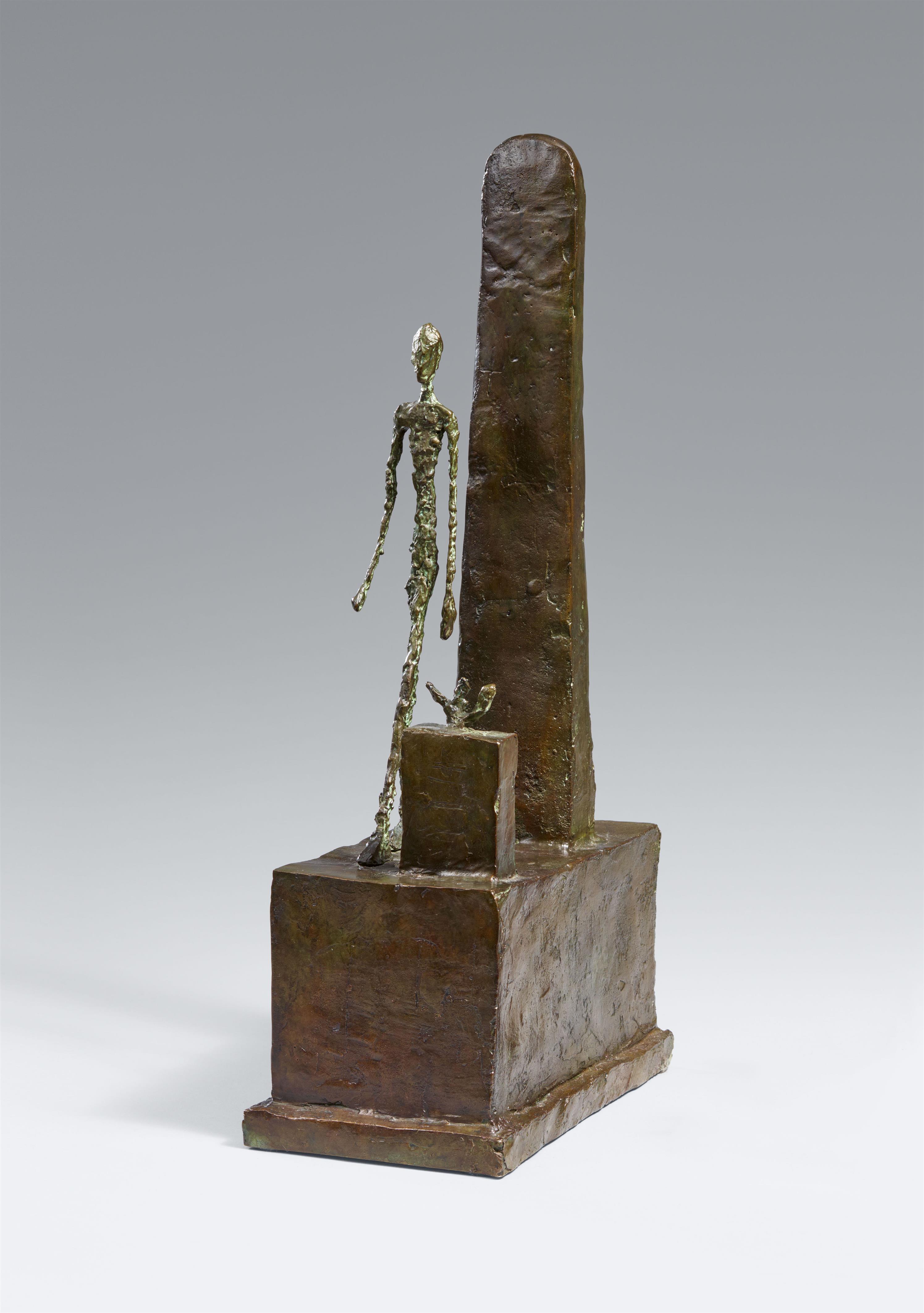Alberto Giacometti
Projet pour un monument pour Gabriel Péri. Projet pour une place
1946
Two bronze sculptures. 39.2 x 10.9 x 18.6 cm and 18.5 x 9.2 x 12.7 cm. Each signed 'A. Giacometti' on the left side of the base as well as numbered and with foundry mark "C.VALSUANI CIRE PERDUE" on the back side. Each numbered 1/8. Cast 1993/1994 in an edition of 8. - Fine greenish-brown patina. - In very good condition.
The monument design “Projet pour un monument pour Gabriel Péri” represents an important milestone in Alberto Giacometti’s oeuvre. It was the first time he realised the important motif of the walking man, which would decisively dominate the rest of his oeuvre and ultimately culminate in his most famous work, the life-size “L’homme qui marche” of 1960.
Directly after the end of World War II, numerous artistic projects were initiated in France to honour the victims and heroes of the Résistance. Alberto Giacometti also participated by developing concepts for a number of these monuments, presumably at the suggestion of Louis Aragon. In 1946 the newspaper “L’Humanité” announced a competition to honour the journalist and Communist MP Gabriel Péri (1902–1941), who had been arrested and killed by the occupying Germans after a public speech in the national assembly. Casimiro Di Crescenzo, Giacometti researcher and member of the Comité Giacometti, has intensively studied the history of this monument design: “The plan was to build a monument to Gabriel Péri that would be installed in front of the station of Saint-Lazare (today Place Gabriel Péri). The location was chosen because this station was the terminus for the trains that served Argenteuil, the town for which Gabriel Péri was deputy. The competition was never concluded since the French Communist Party was ousted from the government in 1947 and the idea of the monument consequently abandoned” (Casimiro Di Crescenzo, Giacometti - Künstler und Revolutionär, in: exh. cat. Alberto Giacometti, Kunsthalle Wien/Edinburgh 1996, Stuttgart 1996, p. 49; idem, Giacometti, Artist and Revolutionary, in: Exh. cat. Alberto Giacometti, Ravenna, Loggetta Lombardesca, 10.10.2004 - 20.2.2005, Milan 2004, p. 56).
Giacometti designed the monumentally dimensioned memorial concept partially in cooperation with the American architect Paul Nelson, who was to design its base. After its realisation had been abandoned, the original concept for the “Projet pour un monument pour Gabriel Péri”, which Alberto Giacometti had still produced without the involvement of Nelson, remained in his studio as a plaster model. It later went to his brother Diego – as did the model “Projet pour une place”, which was also created in this context. In 1993/94 bronze versions were made of these two important plaster pieces, each in an edition of eight casts.
“Projet pour un monument pour Gabriel Péri” marks a decisive point in Alberto Giacometti’s oeuvre, because it was the first time he realised a depiction of a man walking. The sculpture combines the archaic form of an upright stele with the human figure so characteristic of Giacometti’s oeuvre. The slender, thoroughly elongated silhouette of the walking man presents the important shift to his mature style – after his earlier surrealist abstractions had already been replaced by realistic portrait images in the mid 1930s.
“While the artist had used a symbolic idiom borrowed from Early Christian and Egyptian art for the tombstone of his father in 1934 and that of Gerda Taro in 1937–1938 in order to give expression to the idea of immortality, he began to develop a more personal symbolism in ‘Projet pour un monument pour Gabriel Péri’. The composition consists of a walking male figure next to a stele […]. The flame motif is an allusion to the memorial flame at the Tomb of the Unknown Soldier beneath the Arc de Triomphe. For the first time in his post-war sculpture, Giacometti introduced the figure of the man walking, but noiw in relation to ancient Egyptian art in which this theme links entry into the kingdom of the dead with eternal survival. Considering that the sculpture was conceived as a monument, the emergence of the walking male figure cannot be explained by way of theories of perception. It seems persuasive, if […] a mythological dimension is recognised in the artist’s work. Prior to the creation of this sculpture, female walking figures had served as a metaphor for the totality of life, for example, in the drawing ‘Danseuse des corde’, 1943, or the plaster sculpture ‘La nuit’, 1946–1947 – a walking female figure on a sarcophagus-like base, which was conceived as a monument for the French Resistance. Later, in 1950, with ‘Figurine dans une boîte entre deux maisons” and ‘Le chariot’, which was intended as a monument for a public square in Paris, women would only be depicted as standing motionlessly. By contrast, the number of sculptures of walking men increases, including ‘Homme qui marche sous la pluie’, 1948, and ‘Trois hommes qui marchent’, 1948. Even if the works for the competitions mentioned here never advanced beyond a preliminary phase – each for its own different reasons – they nonetheless corresponded to Giacometti’s artistic will to carry out compositions with figures” (Di Crescenzo, op. cit.).
The creation of “Projet pour une place” was directly connected with the Gabriel Péri monument, as is demonstrated by photographs from Diego Giacometti’s studio and, even more so, by design sketches from Alberto Giacometti’s notebook from 1946 (see comparative ill.).
The link with a surrealist work of the same name from 1932 is of particular interest here. In this early design, various abstract forms have taken on a life of their own on a rectangular plinth and are arranged in relation to one another in space while the vertical surge of the rounded stela, which is erected once again in our design from 1946 as a semantically charged monument, is centrally displayed.
“Accordingly, the square would have been identical to the future Place de Gabriel Pétri in front of the Gare Saint-Lazare. The monument symbolises life and death in the form of one growing and one felled tree. […] In terms of the history of its creation, ‘Projet pour une place’ came two to three years before similar sculptures, such as ‘Place’ and ‘Trois hommes qui marchent’” (Di Crescenzo, op. cit.).
Together, the two works stand for the seminal shift in Alberto Giacometti’s development as an artist by uniting two important key symbols, the tree and the stele, with the innovative motif of the walking man to form a highly concentrated ensemble – the essence of Giacometti’s artistic and intellectual vision in 1946.
Catalogue Raisonné
Alberto Giacometti Database (AGD) 3901 and 4060
Certificate
Each with a photo-certificate from Hubert Lacroix, Catherine Grenier and Christian Klemm, Comité Giacometti, Paris, dated March resp. November 2018.
Currently, the Comité Giacometti consists of the following persons: Catherine Grenier, Hubert Lacroix and Casimiro Di Crescenzo.
Provenance
From the circle of the artist's friends; Private collection
Literature
Casimiro Di Crescenzo, Giacometti - Künstler und Revolutionär, in: Exh. cat. Alberto Giacometti, Kunsthalle Wien/Edinburgh 1996, Stuttgart 1996, p. 48-50, cf. cat. no. 117-119; Casimiro Di Crescenzo, Giacometti, Artist and Revolutionary, in: Exh. cat. Alberto Giacometti, Ravenna, Loggetta Lombardesca, 10 Oct. 2004 - 20 Feb. 2005, Milan 2004, p. 55 ff.
Exhibitions
Heilbronn/Künzelsau 1996 (Städtische Museen/Museum Würth), Plätze und Platzzeichen: der Platz - ein Thema der Kleinplastik seit Giacometti, cat. no. 51 and 52; Frankfurt am Main 1998/1999 (Schirn Kunsthalle), Alberto Giacometti. Werke und Schriften, cat. no. 18 and 20, with ill. p. 43 and 45; Milan/Mannheim 2000 (Fondazione Antonio Mazzotta/Städtische Kunsthalle), I Giacometti. La valle, il mondo/Die Familie Giacometti. Das Tal, die Welt, with ill. p. 100

